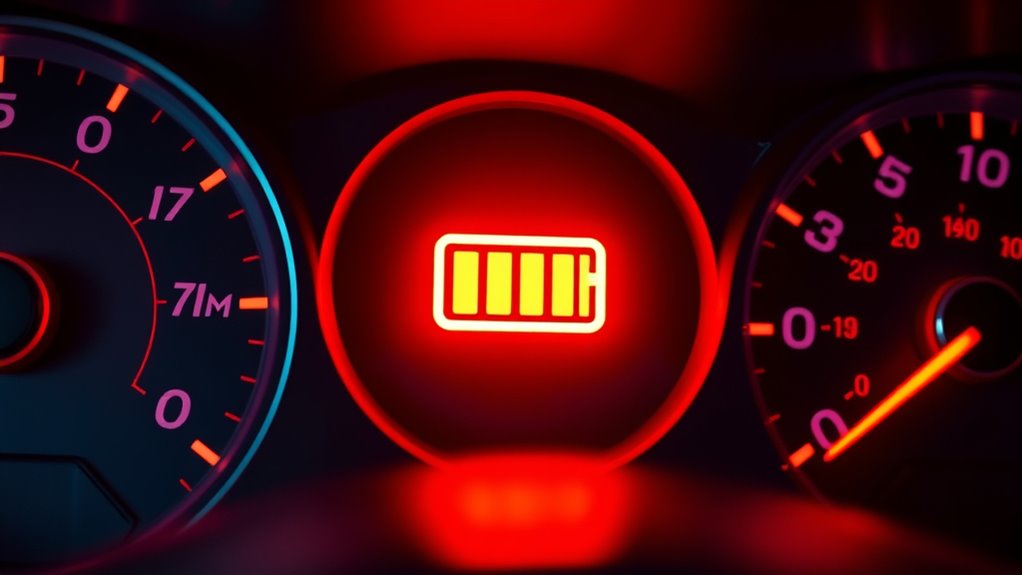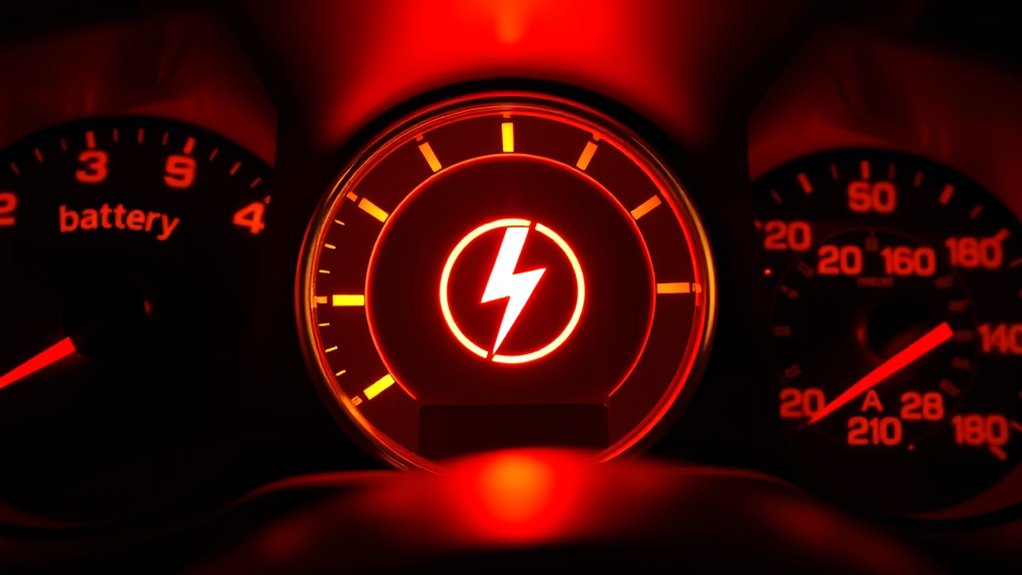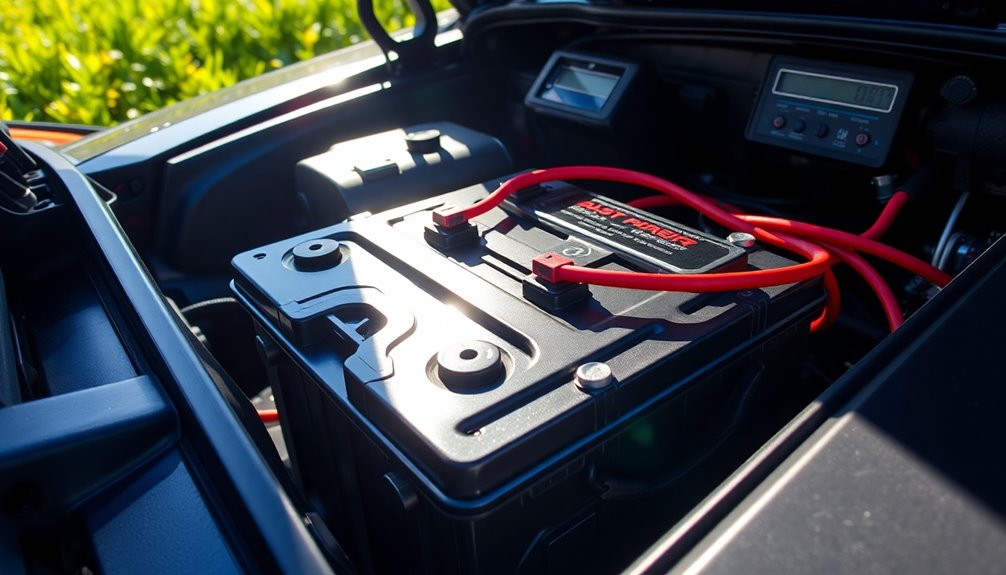If your dashboard shows a battery warning light, don’t ignore it. It signals issues with your charging system, like a failing alternator, loose connections, or a weak battery. Ignoring these alerts can cause your car to break down and lead to costly repairs. It’s important to address the problem promptly by inspecting and maintaining your battery. Keep going to discover how to properly handle these warnings and protect your vehicle’s electrical system.
Key Takeaways
- The battery warning light signals potential issues with the charging system or battery health, needing prompt attention.
- Ignoring dashboard alerts can lead to electrical failures, vehicle breakdowns, and costly repairs.
- Regularly inspecting and maintaining battery terminals prevents warning lights caused by corrosion or loose connections.
- If the warning light appears, diagnose and fix underlying problems before resetting the alert to ensure accurate dashboard readings.
- Proactive battery maintenance, including timely replacements, helps avoid unexpected failures and keeps warning lights from activating.

Your vehicle’s dashboard warning lights for the battery are essential indicators that alert you when there’s an issue with your car’s charging system. Ignoring these signals can lead to unexpected breakdowns and costly repairs. When you see a battery warning light, it’s a sign that your vehicle’s electrical system isn’t functioning properly, often due to a failing alternator, loose or corroded battery terminals, or a faulty battery itself. Addressing the problem promptly helps protect your vehicle’s electrical components and guarantees reliable performance.
Dashboard battery warning lights signal charging system issues; addressing them promptly prevents breakdowns and costly repairs.
One of the key steps in managing battery health is proper battery maintenance. Regularly inspecting your battery terminals for corrosion, making sure they’re tightly connected, and cleaning any buildup can prevent many issues before they escalate. If the warning light appears, it’s imperative to perform a thorough check of the battery and charging system. Sometimes, the cause is simply a loose connection or dirt build-up, which you can fix yourself. However, if the problem persists, it’s best to have a professional diagnose and replace faulty parts. Remember, a weak or failing battery can also trigger the warning light, especially if it can’t hold a charge. Additionally, understanding the contrast ratio of your projector can help you better appreciate the importance of clear visual signals in vehicle dashboards.
Once you’ve addressed the underlying issue, you might need to reset the warning light. Resetting the warning light isn’t complicated, but it’s an important step to guarantee your dashboard accurately reflects the current status. Many modern vehicles allow you to reset the battery warning light through the vehicle’s infotainment system or a specialized scanner. For older models, disconnecting the battery for a few minutes and then reconnecting it can sometimes reset the warning. However, it’s essential to fix the root cause before resetting the light; simply clearing the warning without addressing the problem won’t prevent future alerts or damage.
Preventive maintenance is your best defense against battery-related warning signals. Regularly checking your battery’s condition and replacing it before it completely fails can save you from sudden breakdowns. If you’re unsure about how to perform these checks, consult your vehicle’s owner manual or a qualified mechanic. They can help you perform proper battery maintenance and guarantee the warning light reset is done correctly, giving you peace of mind on the road. Never ignore a battery warning light—taking quick action helps keep your vehicle’s electrical system healthy and prevents inconvenient or dangerous situations down the line.
Frequently Asked Questions
How Do I Reset the Battery Warning Light After Maintenance?
When your warning light appears, you might wonder how to do a battery reset after maintenance. To reset the warning light, turn off your vehicle and disconnect the negative terminal of your battery for about 10 minutes. Reconnect it securely, then start your car. This process usually clears the warning light. If it persists, check your vehicle’s manual or consult a professional to guarantee the reset was successful.
Can a Flashing Battery Light Indicate Other Vehicle Issues?
A flashing battery light can signal more than just a simple warning. It might be alerting you to serious issues like battery corrosion or alternator failure, both of which threaten your vehicle’s core systems. Ignoring this flashing light could lead to unexpected breakdowns or complete power loss. Stay alert, get your vehicle inspected promptly, and don’t underestimate the warning—early detection can save you from costly repairs and dangerous situations.
What Are Common Causes of Battery Warning Lights?
When your battery warning light comes on, it’s often caused by issues like battery corrosion, which hampers power flow, or a problem with your charging system, such as a failing alternator. You might also see this light if your battery is old or has loose connections. To keep your car running smoothly, check for corrosion, make certain your charging system is functioning properly, and replace your battery if needed.
Is It Safe to Drive With a Battery Warning Light On?
If the battery warning light comes on, it’s best to avoid driving long distances. You might need to jump start your car if the battery isn’t holding a charge, but don’t ignore signs like slow engine cranking or dim lights, which indicate battery issues. If these signs persist, consider battery replacement to prevent breakdowns. Always check your owner’s manual for specific advice and safety precautions.
How Often Should I Check My Vehicle’s Battery Health?
Did you know that about 60% of car breakdowns are caused by battery issues? You should check your vehicle’s battery health at least every six months to catch warning light triggers early. Regular battery maintenance helps prevent unexpected failures, saving you time and money. Keep an eye on your battery’s condition through visual checks and testing, especially if your warning light pops up. Consistent checks are key to reliable driving.
Conclusion
Ignoring these battery warning lights is like ignoring a blazing fire in your dashboard’s engine room—you’re risking a breakdown that could leave you stranded in the middle of nowhere. Always pay attention to these signals; they’re your car’s way of warning you about serious issues. Catching problems early can save you from a costly, unexpected failure. Stay vigilant, and your battery will keep your journey smooth and worry-free, like a well-oiled machine cruising effortlessly down the highway.










